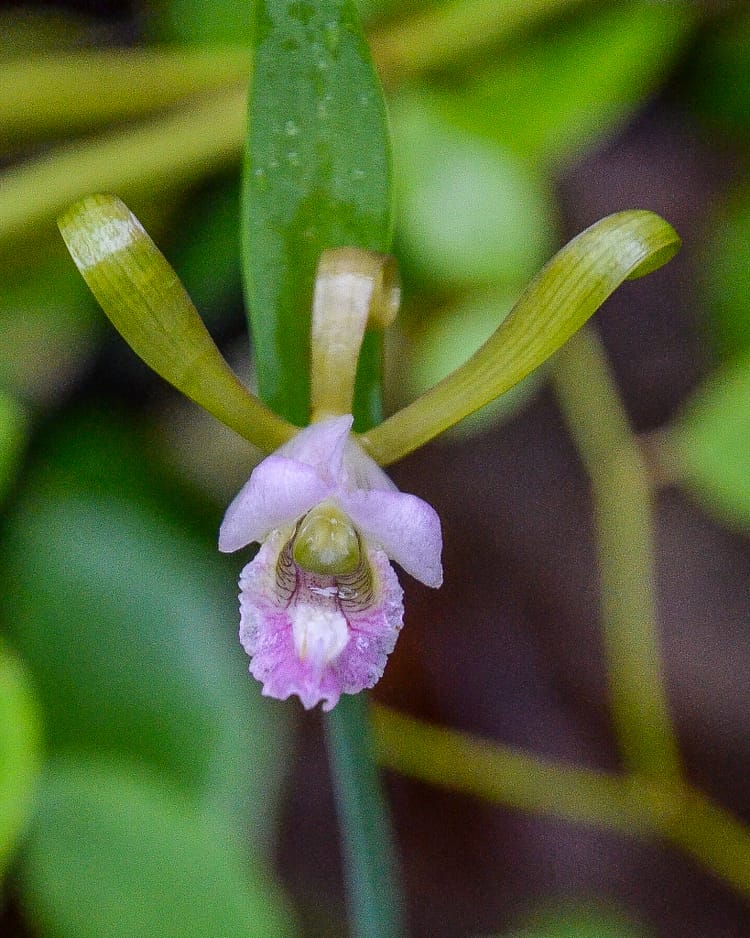This spring has handed us plenty of weather extremes over the past few weeks. Bernie and I left the house early on a Sunday morning, hoping to log a few miles and dodge the rain. We headed for a favorite trail, with a steady uphill climb that passes through a few different plant communities. This trail still shows signs of a major forest fire in 2016. The impact we didn’t expect was the presence of the Rosebud orchid (aka Small Spreading Pogonia), which is often cited as regenerating in response to prescribed burns.
https://e360.yale.edu/features/does-a-fire-ravaged-forest-need-human-help-to-recover
Rosebud Orchid- Cleistes bifaria

As usual, I was headed uphill, trying to strike a balance between firmly planting my foot with each step and swiveling my head about in search of wildflowers. Just off the trail, I spot a tiny pink flower, with a single, clasping leaf on the stem. Deep breath…and I begin shouting and celebrating this find. It was a very wet morning- while the rain hadn’t yet resumed, the herbaceous layer was glistening with precipitation.

This was quite a thrill and I was practically hyperventilating with joy to find this uncommon orchid. The Rosebud Orchid is so dainty and easily hidden among other ground cover. We found about 6 along the trail in a few areas, but there were likely many more that we didn’t spot.
The long tube is formed by the purple or pink petals, with a protruding, ruffled lip below. Surrounding the tube are three green-striped or bronze-colored lateral, recurved sepals, practically rolling out the carpet for bumblebee pollinators. You can learn more about Rosebud Orchid or Spreading Pogonia here:
https://www.fs.fed.us/wildflowers/plant-of-the-week/cleistes_bifaria.shtml

Drinking in the beauty…
Another fascinating species is the Ghost pipe, a saphrophytic plant without chlorophyll, that survives by utilizing the nutrients of other plants. They have an alien appearance, standing at attention and surveying their environment.

Climbing upward, the mist of precipitation became heavier, with low lying clouds nestled among the folds of the mountains. Reluctantly, we turned around as the drizzle increased. The raindrops on intense purple flowers of the spiderwort just illustrated the beauty of this day.

Every plant shimmered in the cool mist. The forest was quiet, punctuated only by the sound of light rain gathering on the layers of shrubs and herbaceous plants.

A profusion of blooms surrounded us as we trekked along in the rain. Galax was widespread, sending up shoots of spiky white blooms.

Fly Poison was another notable find. It is a member of the lily family and sports a gorgeous raceme of white flowers towering over the basal leaves. The Fly Poison flowers turn green as they mature, as shown in this image.

Enjoying our national forests…
We concluded our 6 mile hike, still basking in the discovery of another orchid species hiding among the understory. This hike made me think about forest management. The impact of a wildfire demonstrates the tricky balance of benefits and risks for the forest ecosystem and the people who live and play in these areas.
Nature is ever at work building and pulling down, creating and destroying, keeping everything whirling and flowing, allowing no rest but in rhythmical motion, chasing everything in endless song out of one beautiful form into another.
John Muir: Our National Parks
https://www.sierraclub.org/sierra/what-happens-after-wildfire-sweeps-through-forest
If you love native orchids, check out some of the previous HIKEscape posts: https://hikescape.org/a-bounty-of-native-orchids-and-wildflowers-big-ivy-in-june/
Thanks for reading! The next HIKEscape post will feature mountain views and wildflowers above 6,000 feet in elevation. Happy Trails to you!


